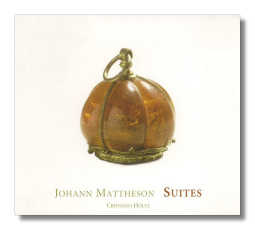
The Internet's Premier Classical Music Source
Related Links
- Latest Reviews
- More Reviews
-
By Composer
-
Collections
DVD & Blu-ray
Books
Concert Reviews
Articles/Interviews
Software
Audio
Search Amazon
Recommended Links
Site News
 CD Review
CD Review
Johann Matheson

Suites from Pièces de clavecin en deux volumes
- Suite #1 in D minor
- Suite #5 in C minor (extracts)
- Suite #4 in G minor (extracts)
- Suite #6 in E Flat Major
- Suite #9 in G minor
- Suite #11 in C Major (extract)
- Suite #12 in F minor (extracts)
Cristiano Holtz, harpsichord
Ramée RAM0605
Here is a collection of three complete and four sets of extracts from Johann Mattheson's Pièces de Clavecin of 1714 harpsichord suites played with great aplomb and vigor by the Brazilian, Cristiano Holtz. Mattheson is well known for his contribution to late Baroque music theory (his most influential works concentrated on musical education, and the relationships between music and rhetoric) and what we would now call criticism (particularly commentaries on contemporary performance practice). But he was an able composer with eight operas and numerous oratorios and cantatas to his credit. If not for the sheer exuberance and highly polished execution of the music on this CD, then for the fact that there are fewer than half a dozen recordings by Mattheson in the catalog should you consider buying it. The playing of this compelling music is indeed so accomplished that if this is in any way repertoire that appeals to you, do not hesitate.
Born (and dying) in Hamburg, Mattheson was a close friend of Handel and married an English woman. Serving also as a diplomat, he had – in good Enlightenment fashion – an interest in and encyclopedic knowledge or awareness of most areas of thought and art of his time. It's appropriate to be impressed by Mattheson's learning and to admire his other rather worldly accomplishments: they are not insignificant. Yet it's as a fervently religious composer of great originality that we should also remember him. This CD plays a welcome part in fostering such appreciation: from the evidence of dignified novelty and restrained feeling in these seven pieces alone, it's high time Mattheson's other music received wider circulation and acclaim. Well done the good people at Ramée for taking this step, and producing an attractive, amply-documented recital.
From such a background as Mattheson's you'd expect urbane and perhaps elevated music. Indeed it is. More spirited and emotionally-charged, perhaps, than that, say, of Rameau… listen to the poignancy of the chromatic opening of the D minor 'Prelude' and the wistfulness of the following 'Allemande'. For every note of poise, there's an energetic pang of pathos or regret. But it's also the variety of Mattheson's melodic invention that strikes the listener. And how sensitively and delicately articulated by Holtz, who apparently learnt to play the harpsichord with his grandmother at the age of seven – only one year later than when Mattheson began! Now in his mid-thirties, Holtz' playing has freshness and certainty in equal measure – again, listen to the way he lays out the chordal progression of the same suite's second 'Double'.
The suites follow the usual French format with (in those offered here) from four to seven dance movements, providing plenty of contrast. Very much in vogue in both France and Germany in the last quarter of the seventeenth and first half of the eighteenth centuries, the term 'suite' is really synonymous with 'partita', 'overture' and 'ordre'. It consisted at heart of pairs of dance movements derived from the French lute traditions of the middle of the seventeenth century. Given Mattheson's deep interest in the theoretical aspects of music, it might be expected that his suites were written as much to explore the properties of those dances' binary forms – pavane/galliard, passamezzo/saltarello etc – as to communicate any innate thematic or melodic musicality. Indeed the composer does accentuate his (and the wider German) taste for a final minuet and a greater role for the air. But this is music qua music and Holtz consistently respects the attendant melodic, rather than purely rhythmic and structural, implications of these choices of form.
Nor is the composer's use of the harpsichord a casual one: for Mattheson that instrument was uniquely capable of furthering the progress of music at the time. So a particularly distilled and focused style and execution of the themes is to be expected. Indeed, the playing on this CD consistently underlines the harpsichord's own distinct idiom – rhythmically dextrous, not gratuitously ornamented and cleverly contrapuntal: quite some way from the French lute despite real and close attention to color.
You'll find a splendidly controlled informality in Holtz' interpretation: the articulation of this gifted keyboard player is free and uncluttered yet meticulous and idiomatic. The suites are presented in no specific order; and note that only three (the first, sixth and ninth) are offered in full here. We have to trust the producers' judgement on this, though it is hard to believe from what is performed that what is left out isn't equally interesting and worthy of inclusion. Another time, perhaps! The liner notes in this Digipak, presented with Ramée's usual style and aesthetic flair, are full and informative. The music – at over 74 minutes – is generous. In short, if this is repertoire that might appeal in its own right, if you're curious about the compositions of Mattheson the writer and theorist, if you just want a good recital of mid-Baroque harpsichord music excellently played, don't hesitate to buy this attractive CD.
Copyright © 2007, Mark Sealey




















